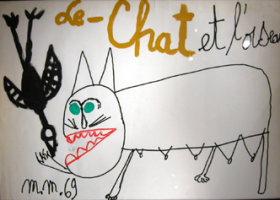Michel Macréau
Michel Macréau (1935-1995) began his career as an illustrator in the Vallauris pottery studios. In the late 1950s, he moved into an old, uninhabited château in the Chevreuse valley near Paris, where he devoted himself entirely to painting. He preferred not to use brushes, squeezing the tubes of paint directly onto the canvas or paper. From 1960 onwards, he painted obsessively on whatever surfaces came to hand, including bed sheets, jute sacking, and planks of wood. His first solo exhibition, at the Raymond Cordier Gallery in 1962, was a great success. Georges Pompidou purchased two of his works. With the support of Cérès Franco, Michel Macréau took part in numerous events in Paris and Brazil.
Although he enjoyed the support of a number of galleries, and despite the purchase of one of his works by the Musée d’Art Moderne in Paris, Michel Macréau fell out of favour in 1969. His works, deemed too unconventional, were not selling. He experienced a number of years of doubt and depression before his works began to attract attention again in the early 1980s when the art world welcomed artists such as Basquiat who owed a great deal to Macréau’s influence.
His work is close to urban graffiti in its spontaneity; indeed he often painted the materials he used as a base as if working directly on walls. He deliberately set out to be provocative, creating a tentacular world in which he staged highly personal scenes. He was one of the first artists to place characters, graphic elements, and writing on the same footing in his works. His direct, profuse style, which provokes reactions of both fascination and rejection, gives free rein to his creativity with uncompromisingly furious energy.
Michel Macréau is a pioneer. He paints on a variety of media (board, linen, wood, woolen cloth…), sometimes directly with tubes of paint. His pictures are full of rhythm and spontaneity, foretelling by twenty years works by artists such as Penck, Combas or Basquiat.
